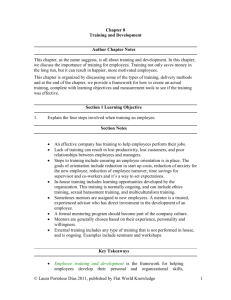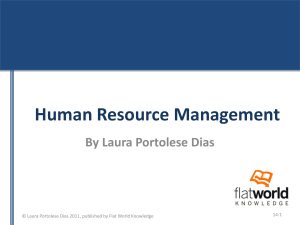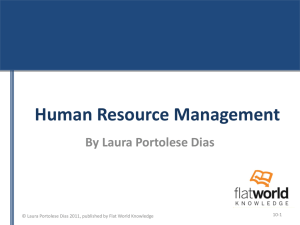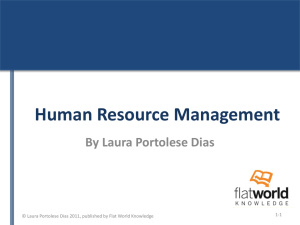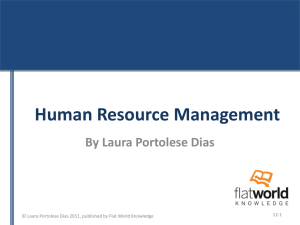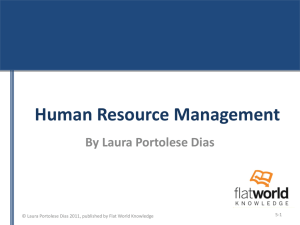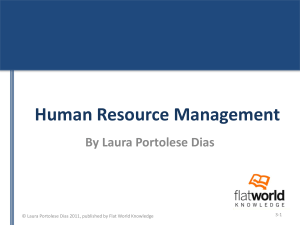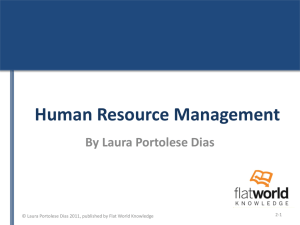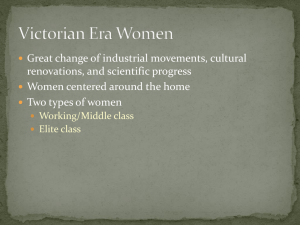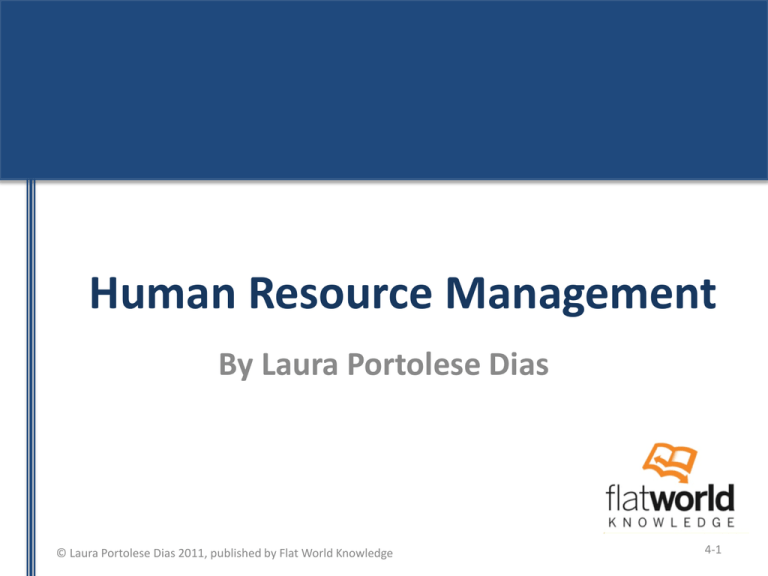
Human Resource Management
By Laura Portolese Dias
© Laura Portolese Dias 2011, published by Flat World Knowledge
4-1
This work is licensed under the Creative Commons Attribution-Noncommercial-Share
Alike 3.0 Unported License.
To view a copy of this license, visit http://creativecommons.org/licenses/by-ncsa/3.0/or send a letter to Creative Commons, 171 Second Street, Suite 300, San
Francisco, California, 94105, USA
© Laura Portolese Dias 2011, published by Flat World Knowledge
4-2
Chapter 4
Recruitment
© Laura Portolese Dias 2011, published by Flat World Knowledge
4-3
Learning Objectives
1. Discuss the need for forecasting human
resource needs and techniques for
forecasting.
2. Explain the steps to an effective
recruitment strategy.
3. Develop a job analysis and job
description.
© Laura Portolese Dias 2011, published by Flat World Knowledge
4-4
The Recruitment Process
• Recruitment
– The process that provides the organization
with a pool of qualified candidates
– Proper staffing plans and forecasting must
occur first
© Laura Portolese Dias 2011, published by Flat World Knowledge
4-5
The Recruitment Process
• Forecasting
– Internal factors
•
•
•
•
•
Budget constraints
Expected or trend of employee separations
Production levels
Sales increases or decreases
Global expansion plans
© Laura Portolese Dias 2011, published by Flat World Knowledge
4-6
The Recruitment Process
• Forecasting
– External factors
•
•
•
•
•
•
Changes in technology
Changes in laws
Unemployment rates
Shifts in population
Shifts in urban, suburban, and rural areas
Competition
© Laura Portolese Dias 2011, published by Flat World Knowledge
4-7
The Recruitment Process
• Aspects of a Recruitment Strategy
– Staffing plans
– Confirm the job analysis is correct through
questionnaires.
– Write the job description and job specifications.
– Have a bidding system to recruit and review
internal candidate qualifications for possible
promotions.
– Determine the best recruitment strategies
for the position.
– Implement a recruiting strategy.
© Laura Portolese Dias 2011, published by Flat World Knowledge
4-8
The Recruitment Process
• Job analysis
– A formal system used to determine what tasks people perform
– Helps ensure creation of the right fit between job and
employee
– Reviewing job responsibilities of current employees
• Job specifications
– A list of tasks, duties and responsibilities of a job
• Job description
– Identifies skills and abilities (based on job analysis
and job specification) needed to be successful
at a job
© Laura Portolese Dias 2011, published by Flat World Knowledge
4-9
The Recruitment Process
• Two types of job analysis
– Task-based analysis
• Focus on job duties required
• Specific tasks are clearly listed, such as
– “Assist customers with product questions”
– Competency- or skills-based analysis
• Focus on how a person applies skills
• More objective, such as
– “Able to utilize data analysis tools”
© Laura Portolese Dias 2011, published by Flat World Knowledge
4-10
The Recruitment Process
• Job analysis process
– Job analysis questionnaire to all employees
– Organization of employee data
– Job analysis written for each position in the
organization
– Job description/job specifications written
based on job analysis data
© Laura Portolese Dias 2011, published by Flat World Knowledge
4-11
The Recruitment Process
• Job description should include
– Job functions (the tasks the employee
performs)
– Knowledge, skills, and abilities (what an
employee is expected to know and be able to
do, as well as personal attributes)
– Education and experience required
– Physical requirements of the job
(e.g., ability to lift, see, or hear)
© Laura Portolese Dias 2011, published by Flat World Knowledge
4-12
Learning Objective
1. Explain the Immigration Reform and
Control Act (IRCA), Patriot Act, and
Equal Employment Opportunity (EEO)
laws and how they relate to recruiting.
© Laura Portolese Dias 2011, published by Flat World Knowledge
4-13
The Law and Recruitment
• Immigration Reform and Control Act
– Adopted in 1986
– Requires employers to attest to their
employees’ immigration status
– Makes it illegal to hire or recruit illegal
immigrants
– Responsible for subcontracting
– Be able to show I-9 forms for all
workers
© Laura Portolese Dias 2011, published by Flat World Knowledge
4-14
The Law and Recruitment
• Patriot Act
– As a result of 9/11
– Enhances the Federal Government’s ability to
conduct domestic and international investigations
and surveillance
– Employers implementation on new procedures to
maintain employee privacy rights, but still allow for
releases of requested information
– Patriot Act amended Electronic Communications
Privacy Act, which allows for easier access to
electronic communications
© Laura Portolese Dias 2011, published by Flat World Knowledge
4-15
The Law and Recruitment
• EEO Laws
– Equal Employment Opportunity Laws
– Employers with 15 or more employees
– No discrimination in hiring due to age, disability,
genetic information, national origin, sex, pregnancy,
race, and religion
• Disparate impact
– When discrimination occurs due to the type of hiring
process used
• Disparate treatment
– One person is treated differently than another
© Laura Portolese Dias 2011, published by Flat World Knowledge
4-16
Learning Objective
1. Explain the various strategies that can
be used in recruitment.
© Laura Portolese Dias 2011, published by Flat World Knowledge
4-17
Recruitment Strategies
• Recruitment plans
– Specifies where you will recruit and timelines
© Laura Portolese Dias 2011, published by Flat World Knowledge
4-18
Recruitment Strategies
• Recruiters
– A specific individual who focuses solely on
the recruiting function
• Executive search firms
• Temporary recruitment or staffing firms
• Corporate recruiters
© Laura Portolese Dias 2011, published by Flat World Knowledge
4-19
Recruitment Strategies
•
•
•
•
•
•
•
Campus Recruiting
Professional Associations
Websites
Social Media
Events
Special-Interest Groups
Referrals
© Laura Portolese Dias 2011, published by Flat World Knowledge
4-20
Recruitment Strategies
© Laura Portolese Dias 2011, published by Flat World Knowledge
4-21
Recruitment Strategies
© Laura Portolese Dias 2011, published by Flat World Knowledge
4-22
Recruitment Strategies
© Laura Portolese Dias 2011, published by Flat World Knowledge
4-23
Recruitment Strategies
• Costs of recruitment
Cost per hire = advertising costs + recruiter costs +
referral costs + social media costs + event costs /
the number of hires in the time period
• Yield ratio
– Looks at how effective recruiting methods are
– Percentage of applicants from one source who make
it to the next stage in the selection process
© Laura Portolese Dias 2011, published by Flat World Knowledge
4-24

